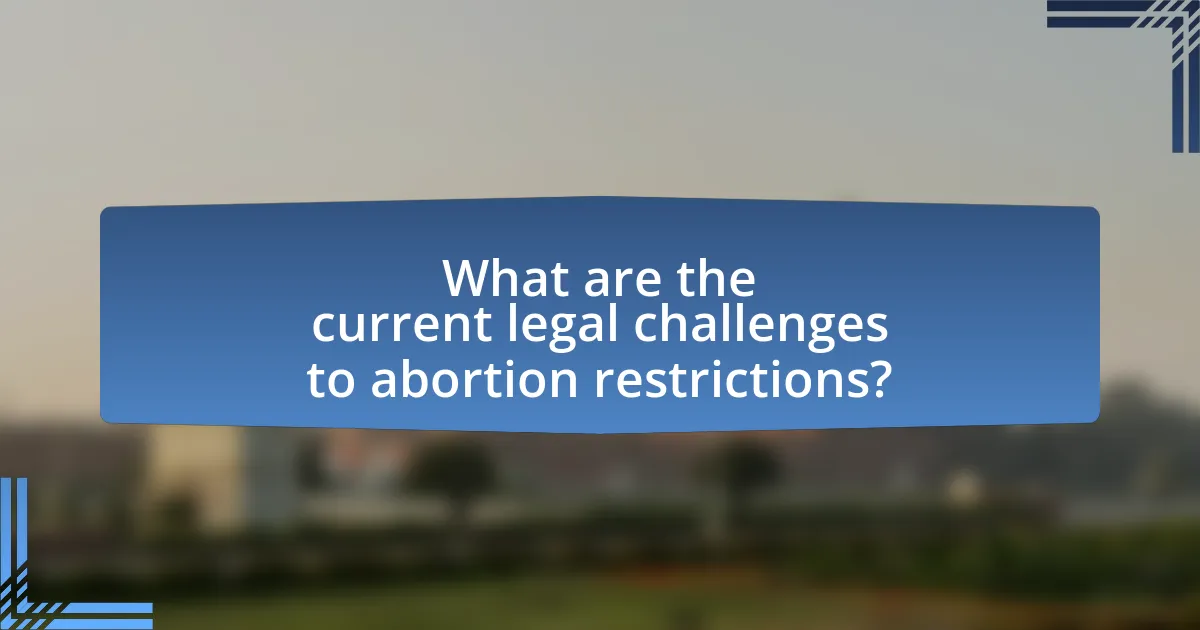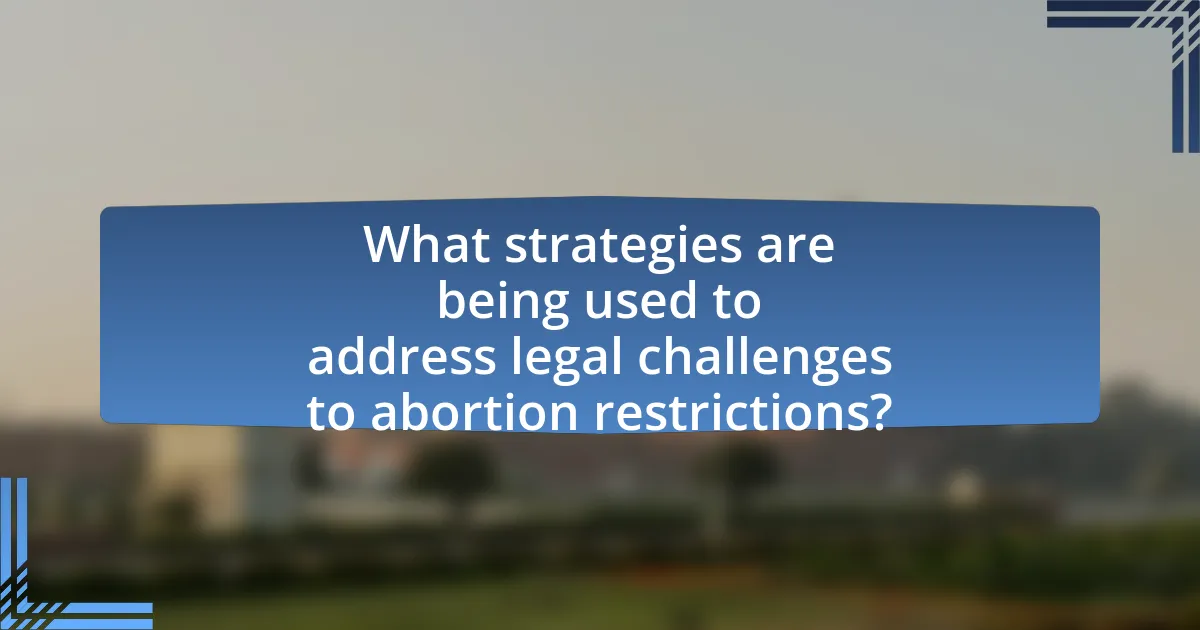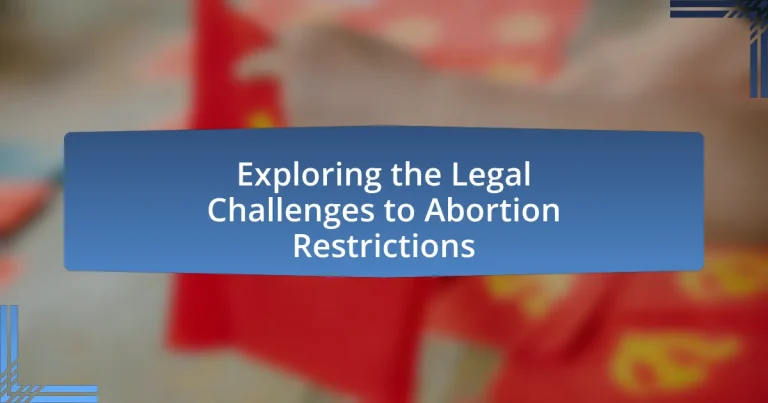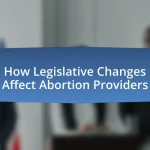The article examines the current legal challenges to abortion restrictions in the United States, highlighting ongoing lawsuits against state laws that impose barriers to accessing abortion services. It discusses the significant variation in state laws, the common types of restrictions such as mandatory waiting periods and gestational limits, and the impact these laws have on access to abortion. The article also explores the role of federal laws and Supreme Court decisions, particularly the implications of the Dobbs v. Jackson Women’s Health Organization ruling, which overturned Roe v. Wade. Additionally, it addresses the arguments against abortion restrictions, the strategies employed by advocacy groups, and the broader societal implications of increased access to abortion services.

What are the current legal challenges to abortion restrictions?
Current legal challenges to abortion restrictions primarily involve lawsuits contesting state laws that impose significant barriers to accessing abortion services. For instance, several states have enacted laws that ban abortions after a certain gestational age, which are being challenged in courts on the grounds that they violate the constitutional right to access abortion established by the Supreme Court in Roe v. Wade. Additionally, legal actions are being taken against laws requiring mandatory waiting periods, parental consent for minors, and restrictions on medication abortions. These challenges are often supported by organizations such as the American Civil Liberties Union and Planned Parenthood, which argue that such restrictions disproportionately affect low-income individuals and people of color, thereby violating principles of equal protection under the law.
How do state laws vary regarding abortion restrictions?
State laws regarding abortion restrictions vary significantly across the United States, with some states implementing strict limitations while others maintain more permissive regulations. For instance, states like Texas and Alabama have enacted laws that impose bans on abortions after a certain number of weeks, often as early as six weeks, which can be before many individuals even realize they are pregnant. Conversely, states such as California and New York uphold more liberal policies, allowing abortions up to the point of viability or even later under specific circumstances. This disparity is further evidenced by the fact that as of 2023, over 20 states have passed laws that severely restrict or ban abortions, while others have enacted protections to safeguard access to abortion services.
What are the most common types of abortion restrictions imposed by states?
The most common types of abortion restrictions imposed by states include mandatory waiting periods, parental consent laws, gestational limits, and targeted regulation of abortion providers (TRAP laws). Mandatory waiting periods require individuals to wait a specified time, often 24 to 72 hours, after an initial consultation before obtaining an abortion. Parental consent laws mandate that minors obtain permission from a parent or guardian before proceeding with the procedure. Gestational limits restrict abortions after a certain point in pregnancy, typically around 20 weeks. TRAP laws impose stringent requirements on abortion clinics, such as facility standards and licensing, which can lead to clinic closures. These restrictions have been enacted in various states, reflecting ongoing legal and political debates surrounding abortion access.
How do these restrictions impact access to abortion services?
Restrictions on abortion services significantly limit access by imposing barriers such as mandatory waiting periods, parental consent laws, and gestational limits. These barriers can lead to delays in obtaining services, increased travel distances to clinics, and higher costs, ultimately reducing the number of individuals who can access safe and legal abortions. For instance, a study by the Guttmacher Institute found that states with more restrictive abortion laws experience a decrease in the number of facilities providing these services, which directly correlates with reduced access for individuals seeking abortions.
What role do federal laws play in abortion restrictions?
Federal laws significantly influence abortion restrictions by establishing constitutional protections and regulatory frameworks. The landmark Supreme Court decision in Roe v. Wade (1973) recognized a woman’s right to choose abortion under the right to privacy, thereby limiting states’ ability to impose restrictive laws. Subsequent federal legislation, such as the Women’s Health Protection Act, aims to safeguard access to abortion services against state-level restrictions. Additionally, federal courts often adjudicate cases involving abortion laws, determining their constitutionality and enforcing federal protections. These legal precedents and legislative measures collectively shape the landscape of abortion access and restrictions across the United States.
How has the Supreme Court influenced abortion rights over the years?
The Supreme Court has significantly influenced abortion rights through landmark rulings that have shaped legal precedents. The most notable case is Roe v. Wade (1973), where the Court recognized a woman’s constitutional right to privacy, effectively legalizing abortion nationwide. This decision established a framework that allowed states to regulate abortion but prohibited outright bans during the first trimester. Subsequent cases, such as Planned Parenthood v. Casey (1992), reaffirmed Roe while allowing states to impose certain restrictions, provided they did not place an “undue burden” on a woman’s right to choose. More recently, the Supreme Court’s decision in Dobbs v. Jackson Women’s Health Organization (2022) overturned Roe v. Wade, granting states the authority to regulate or ban abortion entirely, thus drastically altering the landscape of abortion rights in the United States. These rulings illustrate the Court’s pivotal role in defining and redefining abortion rights over the years.
What recent Supreme Court cases have shaped the current legal landscape?
Recent Supreme Court cases that have shaped the current legal landscape include Dobbs v. Jackson Women’s Health Organization, which overturned Roe v. Wade, fundamentally altering abortion rights in the United States. This decision, issued in June 2022, allowed states to regulate or ban abortions, leading to significant legal and social implications across the country. The ruling has prompted various states to enact stricter abortion laws, while others have moved to protect access, illustrating the ongoing legal challenges surrounding abortion restrictions.
What arguments are being made against abortion restrictions?
Arguments against abortion restrictions emphasize women’s rights, bodily autonomy, and public health. Advocates assert that restricting access to abortion infringes on a woman’s right to make decisions about her own body, which is a fundamental aspect of personal freedom and privacy. Furthermore, studies indicate that access to safe and legal abortion services is crucial for protecting women’s health; for instance, the World Health Organization states that unsafe abortions contribute significantly to maternal mortality. Additionally, opponents argue that restrictions disproportionately affect low-income women and marginalized communities, exacerbating existing inequalities in healthcare access. These arguments collectively highlight the need for legal protections that ensure equitable access to reproductive healthcare.
What constitutional rights are cited in challenges to abortion restrictions?
The constitutional rights cited in challenges to abortion restrictions primarily include the right to privacy and the right to due process. The right to privacy, established in cases such as Roe v. Wade (1973), asserts that individuals have the autonomy to make decisions regarding their own bodies, including the choice to terminate a pregnancy. Additionally, the right to due process, protected under the Fourteenth Amendment, ensures that laws affecting personal liberties must be fair and not arbitrary. These rights form the basis for legal arguments against various state-imposed restrictions on abortion, emphasizing the importance of personal choice and legal protections in reproductive health decisions.
How do advocates frame the debate around women’s health and autonomy?
Advocates frame the debate around women’s health and autonomy by emphasizing the fundamental right of women to make decisions about their own bodies. They argue that access to comprehensive healthcare, including reproductive services, is essential for women’s physical and mental well-being. For instance, the Guttmacher Institute reports that restricting access to abortion services can lead to negative health outcomes, highlighting the importance of autonomy in healthcare decisions. Advocates also connect women’s health to broader social justice issues, asserting that marginalized communities face disproportionate barriers to accessing necessary healthcare, thus framing the debate as one of equity and human rights.

What are the implications of legal challenges to abortion restrictions?
Legal challenges to abortion restrictions can lead to significant changes in reproductive rights and access to healthcare. These challenges often result in court rulings that can either uphold or strike down restrictive laws, influencing the legal landscape surrounding abortion. For instance, the Supreme Court’s decision in Roe v. Wade established a constitutional right to abortion, which has been challenged and reaffirmed in various cases, impacting state laws and access to services. Additionally, successful legal challenges can set precedents that affect future legislation, potentially expanding access to abortion services and shaping public policy.
How do legal challenges affect public policy on abortion?
Legal challenges significantly influence public policy on abortion by prompting legislative reviews and potential reforms. When courts rule on abortion-related cases, they can invalidate existing laws or set new legal precedents, which forces policymakers to reconsider their positions and adapt regulations accordingly. For instance, the U.S. Supreme Court’s decision in Roe v. Wade (1973) established a constitutional right to abortion, which shaped state laws and public policy for decades. Conversely, recent challenges to Roe, such as the 2022 Dobbs v. Jackson Women’s Health Organization ruling, have led to a wave of state-level restrictions and changes in public policy across various jurisdictions, reflecting the direct impact of legal rulings on abortion access and regulation.
What changes have occurred in states with successful legal challenges?
States with successful legal challenges to abortion restrictions have experienced significant changes, including the reinstatement of access to abortion services and the invalidation of restrictive laws. For example, in states like California and New York, courts have overturned laws that imposed waiting periods and mandatory counseling, thereby enhancing access to abortion care. Additionally, these legal victories have led to the establishment of more protective state policies, such as the codification of abortion rights into state law, as seen in Illinois and New Jersey. These changes reflect a broader trend of judicial intervention aimed at safeguarding reproductive rights in response to legal challenges.
How do these challenges influence public opinion on abortion?
Legal challenges to abortion restrictions significantly influence public opinion by highlighting the complexities and implications of reproductive rights. These challenges often bring attention to the personal stories and health impacts associated with abortion, swaying public sentiment towards a more supportive stance. For instance, when courts rule against restrictive laws, it can lead to increased awareness and discussions about women’s autonomy and healthcare access, thereby shifting public perception. Research indicates that states with more legal challenges to restrictive abortion laws tend to show higher levels of public support for abortion rights, as seen in surveys conducted by organizations like the Guttmacher Institute, which found that 70% of Americans believe abortion should be legal in all or most cases when faced with restrictive legislation.
What are the potential consequences of overturning abortion restrictions?
Overturning abortion restrictions can lead to increased access to reproductive healthcare, resulting in higher rates of abortion services being utilized. Studies indicate that when restrictions are lifted, women are more likely to seek abortions, as evidenced by data from states that have relaxed their laws, showing a rise in abortion rates. Additionally, the removal of restrictions may reduce the number of unsafe abortions, as women gain access to regulated medical facilities. Research from the Guttmacher Institute highlights that countries with fewer restrictions on abortion tend to have lower maternal mortality rates, demonstrating a direct correlation between access to safe abortion services and improved health outcomes for women.
How might access to abortion services change if restrictions are lifted?
Access to abortion services would likely increase significantly if restrictions are lifted. Studies indicate that when legal barriers are removed, the availability of abortion providers rises, leading to greater access for individuals seeking these services. For instance, research from the Guttmacher Institute shows that states with fewer restrictions have higher rates of abortion provision, which correlates with improved access for women. Additionally, lifting restrictions can reduce the stigma associated with seeking abortions, further encouraging individuals to utilize available services.
What are the broader societal implications of increased access to abortion?
Increased access to abortion leads to significant societal implications, including improved women’s health outcomes, enhanced economic stability, and greater gender equality. Research indicates that when women have access to safe and legal abortion services, maternal mortality rates decrease, as evidenced by a study published in The Lancet, which found that countries with restrictive abortion laws have higher rates of maternal deaths. Furthermore, access to abortion allows women to make informed choices about their reproductive health, which can lead to better educational and career opportunities, ultimately contributing to economic growth. A report from the Guttmacher Institute highlights that women who can control their reproductive lives are more likely to participate in the workforce and achieve higher levels of education, fostering gender equality. Thus, the broader societal implications of increased access to abortion encompass health, economic, and social dimensions that collectively enhance the well-being of communities.

What strategies are being used to address legal challenges to abortion restrictions?
Legal challenges to abortion restrictions are being addressed through litigation, legislative advocacy, and public mobilization. Organizations such as the American Civil Liberties Union (ACLU) and Planned Parenthood are actively filing lawsuits against restrictive laws, arguing that they violate constitutional rights established by precedents like Roe v. Wade. Additionally, state-level advocacy groups are working to introduce and support legislation that protects access to abortion services, countering restrictive measures. Public mobilization efforts, including protests and awareness campaigns, aim to galvanize community support and influence public opinion, which can lead to changes in policy and law. These strategies collectively aim to safeguard reproductive rights and challenge the legality of restrictive abortion laws.
How are advocacy groups mobilizing to challenge abortion restrictions?
Advocacy groups are mobilizing to challenge abortion restrictions through coordinated legal strategies, grassroots organizing, and public awareness campaigns. These organizations, such as the American Civil Liberties Union and Planned Parenthood, are filing lawsuits against restrictive laws, leveraging legal precedents established by cases like Roe v. Wade. Additionally, they are engaging communities by organizing rallies, providing educational resources, and utilizing social media to amplify their messages. This multifaceted approach aims to not only contest existing laws but also to influence public opinion and legislative processes, thereby reinforcing their commitment to reproductive rights.
What legal strategies are being employed by these groups?
Legal strategies employed by groups challenging abortion restrictions include filing lawsuits based on constitutional rights, particularly the right to privacy and bodily autonomy. These groups often argue that restrictive laws violate the precedents set by landmark cases such as Roe v. Wade and Planned Parenthood v. Casey, which affirm the legal right to access abortion services. Additionally, they utilize public interest litigation to highlight the disproportionate impact of these restrictions on marginalized communities, thereby seeking to establish broader legal precedents that protect reproductive rights.
How do grassroots movements contribute to legal challenges?
Grassroots movements contribute to legal challenges by mobilizing public support and raising awareness about issues, which can lead to increased pressure on lawmakers and judicial systems. For instance, movements advocating for abortion rights have successfully organized campaigns that highlight personal stories and injustices, influencing public opinion and prompting legal action against restrictive laws. Research indicates that grassroots activism can result in significant legal outcomes, as seen in cases where public demonstrations and advocacy efforts have led to court challenges that ultimately reshape legislation.
What role does public awareness play in legal challenges to abortion restrictions?
Public awareness significantly influences legal challenges to abortion restrictions by mobilizing public opinion and shaping the political landscape. Increased awareness often leads to heightened advocacy efforts, which can result in greater public support for reproductive rights and pressure on lawmakers to reconsider restrictive measures. For instance, the widespread protests and campaigns surrounding the 2016 Whole Woman’s Health v. Hellerstedt case highlighted how public sentiment can impact judicial outcomes, as the Supreme Court ultimately ruled against Texas’s restrictive abortion laws. This demonstrates that when the public is informed and engaged, it can directly affect the legal framework surrounding abortion rights.
How can education and outreach impact the success of legal challenges?
Education and outreach significantly enhance the success of legal challenges by increasing public awareness and mobilizing community support. When individuals are informed about their rights and the implications of legal restrictions, they are more likely to engage in advocacy efforts, which can lead to greater visibility and pressure on policymakers. For instance, campaigns that educate the public about the consequences of abortion restrictions have historically resulted in increased participation in legal actions, as seen in cases like Whole Woman’s Health v. Hellerstedt, where public support played a crucial role in the outcome. Furthermore, outreach initiatives can provide essential resources and information to those directly affected, empowering them to participate in legal processes and share their experiences, which can be pivotal in shaping judicial perspectives.
What are effective methods for raising awareness about abortion rights?
Effective methods for raising awareness about abortion rights include organizing educational campaigns, leveraging social media platforms, and collaborating with advocacy groups. Educational campaigns can provide accurate information about reproductive rights and legal frameworks, helping to dispel myths and misinformation. Social media platforms, such as Twitter and Instagram, enable rapid dissemination of information and mobilization of supporters, as evidenced by the #ShoutYourAbortion movement, which has successfully engaged thousands in discussions about personal experiences and rights. Collaborating with advocacy groups, like Planned Parenthood, can amplify messages and reach broader audiences through established networks and resources. These methods have proven effective in increasing public understanding and support for abortion rights.
What practical steps can individuals take to support abortion rights?
Individuals can support abortion rights by advocating for policy changes, volunteering with reproductive health organizations, and educating themselves and others about reproductive rights. Advocacy can involve contacting legislators to express support for pro-choice legislation, participating in rallies, and joining local or national organizations that promote abortion rights. Volunteering with organizations such as Planned Parenthood or the National Abortion Federation provides direct support to those seeking reproductive health services. Education is crucial; individuals can share accurate information about abortion rights and access, helping to counter misinformation and stigma. According to the Guttmacher Institute, states with strong advocacy and support networks have better access to reproductive health services, demonstrating the impact of individual actions on broader legal and social outcomes.

